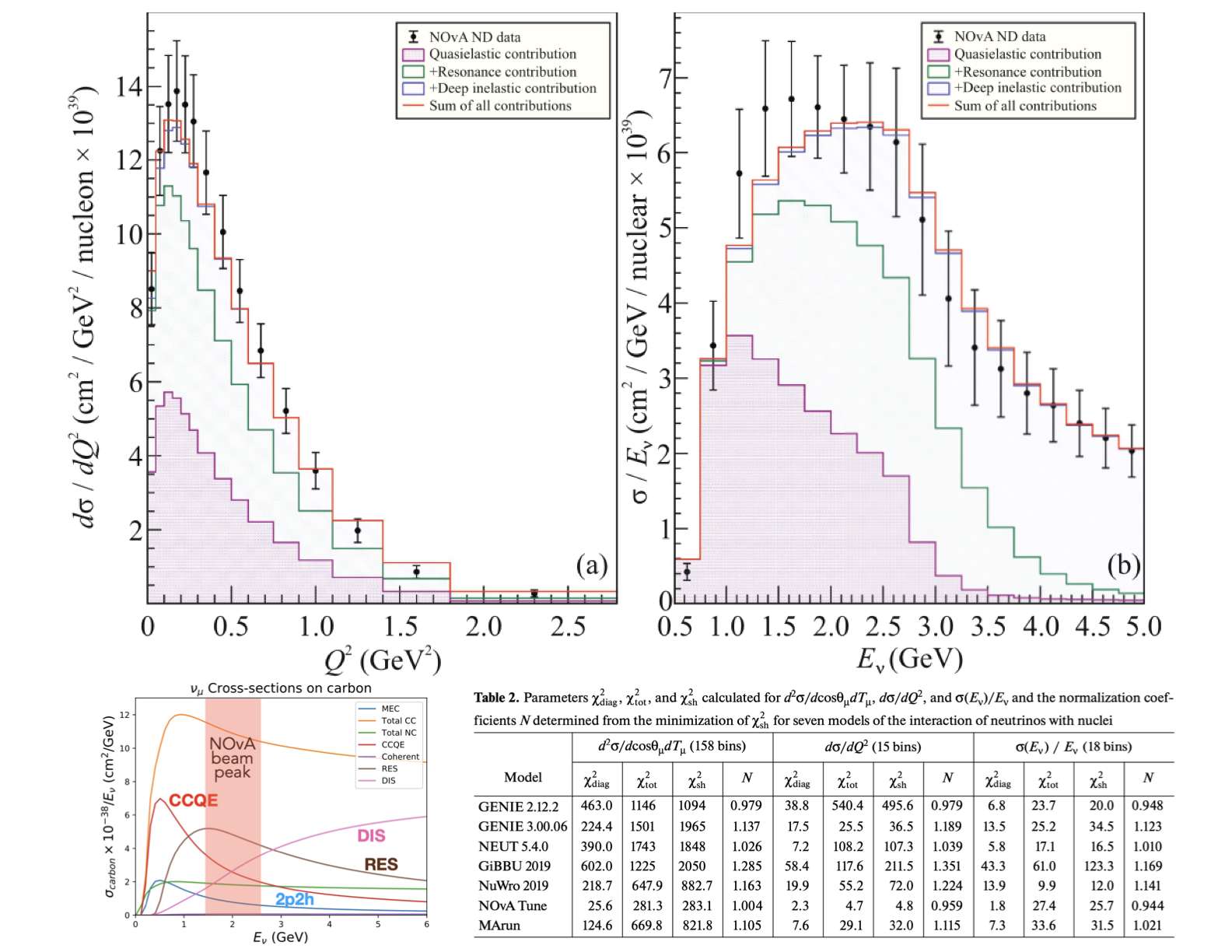The NOvA experiment, primarily focused on neutrino oscillation studies [1], also provides a rich dataset for probing neutrino interaction models. In this project, we evaluate the performance of different models, whose tunes are integrated into the GENIE neutrino event generator [2], by comparing its predictions with several recent NOvA measurements [3, 4, 5]. The comparative analysis will be carried out in a similar way made in the recent publication [6]. More information in attached pdf.
Tasks
Students will evaluate the performance of different neutrino interaction model, integrated into the GENIE neutrino generator, by comparing they with recent experimental measurements from the NOvA experiment. They will focus on the following three sets of data:
• Measurement of d2σ/d|⃗q |dEavail in charged current neutrino-nucleus interactions at Eν = 1.86 GeV using the NOvA Near Detector [3].
• Measurement of the double-differential cross section of muon-neutrino charged-current interactions with low hadronic energy in the NOvA Near Detector [4].
• Measurement of the νe-Nucleus Charged-Current Double-Differential Cross Section at Eν = 2.4 GeV using NOvA [5].
Each of suggested analysis could be done by individual analyzer (student) within the following workflow:
1. Literature Review. Students start by reviewing the published NOvA papers to understand the experimental results and cross-section measurements.
2. GENIE Simulations. Students will configure and run Monte Carlo simulations using GENIE with an included model. They will generate simulated neutrino events at the appropriate neutrino energies (based on each dataset).
3. Data Comparison:
• For each dataset, students will plot the model predictions against the NOvA experimental data.
• Compute double-differential cross sections from simulation and compare them with the data in terms of key variables like muon kinematics (angle, energy) or transfered and visible energies.
4. Statistical Analysis:
• Calculate chi-squared metric to quantify the agreement between the model predictions and the experimental data.
• Identify any discrepancies and hypothesize possible reasons for mismatches.
5. Presentation of Results. Students will prepare reports or presentations summarizing their findings, discussing the effectiveness of the model and any observed shortcomings. They can also propose further improvements or alternative models for future testing.
Preliminary schedule by topics/tasks
The duration of this project is 4-6 weeks. The work schedule will be agreed upon with the students.
Required skills
• Basic knowlegde of neutrino interactions theory/phenomenology (helpful to start).
• Basic knowledge of Linux; programmimg on C++ and analyse HEP data with ROOT (helpful to start).
• A personal laptop or computer with a Linux system installed. A Linux virtual machine will be provided to computentional jobs.
• English or Russian language for communication.
Acquired skills and experience
As part of their work on neutrino interaction analysis using the GENIE generator and NOvA experimental data, the students are developing a broad set of valuable skills and gaining practical experience across several key areas of particle physics and data science. This project equips them with not only theoretical knowledge but also the ability to apply advanced analytical techniques to real-world experimental data. Below are the specific areas where students are building expertise:
1. Particle Physics
The students are acquiring a foundational understanding of particle physics, particularly in the realm of neutrino interactions. They are learning about how neutrinos interact with atomic nuclei and the intricacies of neutrino-nucleus scattering processes, such as charged-current quasielastic (CCQE) scattering, so-called CCQE-like, 2p2h and resonance production. In addition, they are gaining insights into how nuclear effects, such as final-state interactions and nuclear binding energy, influence the observed interactions. As they engage with NOvA’s cross-section measurements, students are also becoming familiar with how experimental techniques are applied to measure and interpret these fundamental physical quantities, providing a clear link between theory and experiment in particle physics.
2. Monte Carlo Simulations
The project involves extensive use of Monte Carlo simulations, particularly through the GENIE neutrino event generator, which is widely used in the neutrino physics community. Students are learning how to configure GENIE to simulate neutrino interactions under various conditions, including different neutrino energies, interaction channels, and nuclear targets. This hands-on experience with GENIE allows students to understand the role of theoretical models in predicting interaction cross-sections and the importance of accurate simulations in experimental particle physics.
3. Data Analysis
A crucial component of the project is the comparison of simulated results with experimental data from NOvA. Through this process, students are developing critical data analysis skills. They are learning how to extract and process large datasets, compute relevant physical quantities, and generate cross-section measurements from both experimental and simulated data. They are also becoming proficient in statistical methods used to evaluate the performance of theoretical models, such as chi-squared tests and goodness-of-fit analyses. This allows them to quantitatively assess how well the simulation aligns with experimental observations. Furthermore, they are gaining experience in visualizing complex results, comparing multiple variables (such as energy and angle), and interpreting any discrepancies between the data and model predictions, honing their ability to critically analyze and communicate scientific findings.
Recommended literature
[1] M. A. Acero et al., “Improved measurement of neutrino oscillation parameters by the NOvA experiment,” Phys. Rev. D, vol. 106, no. 3, p. 032004, 2022.
[2] L. Alvarez-Ruso, C. Andreopoulos, A. Ashkenazi, et al., “Recent highlights from GENIE v3,” Eur. Phys. J. ST, vol. 230, no. 24, pp. 4449–4467, 2021.
[3] M. A. Acero et al., “Measurement of d2sigma/d—q—dEavail in charged current neutrino-nucleus interactions at <Ev> = 1.86 GeV using the NOvA Near Detector,” 10 2024.
[4] M. A. Acero et al., “Measurement of the double-differential cross section of muon-neutrino charged-current interactions with low hadronic energy in the NOvA Near Detector,” 10 2024.
[5] M. A. Acero et al., “Measurement of the νe−Nucleus Charged-Current Double-Differential Cross Section at ⟨Eν ⟩ = 2.4 GeV using NOvA,” Phys. Rev. Lett., vol. 130, no. 5, p. 051802, 2023.
[6] I. D. Kakorin, V. A. Naumov, and O. B. Samoylov, “Test of the Model of “Running Axial Mass” Using NOvA Near Detector Data on Muon Neutrino Scattering on Nuclei,” JETP Lett., vol. 119, no. 11, pp. 813–822, 2024.
[7] M. A. Acero et al., “Measurement of the double-differential muon-neutrino charged-current inclusive cross section in the NOvA near detector,” Phys. Rev. D, vol. 107, no. 5, p. 052011, 2023.



